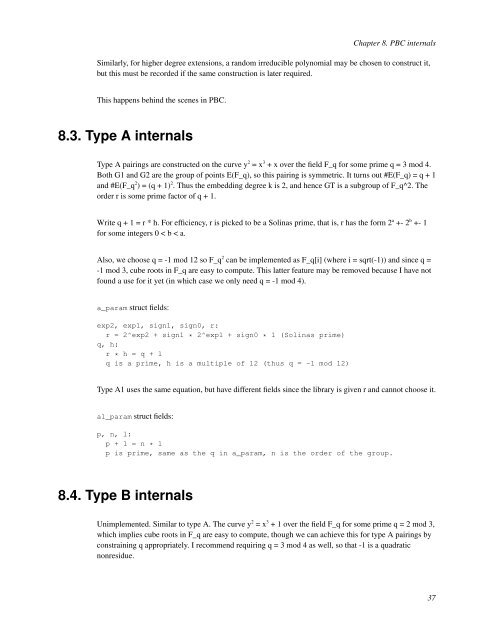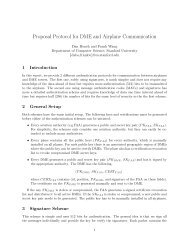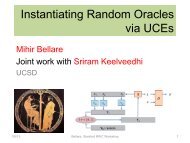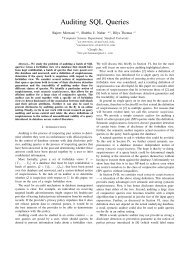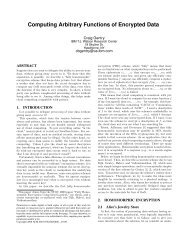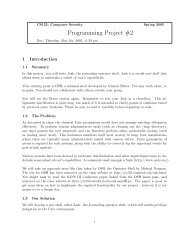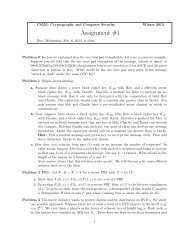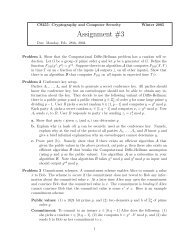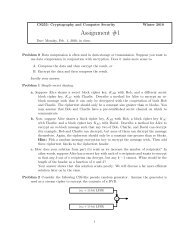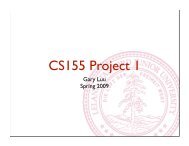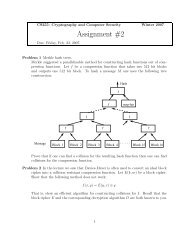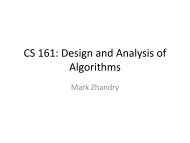PBC Library Manual 0.5.11 - Stanford Crypto Group
PBC Library Manual 0.5.11 - Stanford Crypto Group
PBC Library Manual 0.5.11 - Stanford Crypto Group
Create successful ePaper yourself
Turn your PDF publications into a flip-book with our unique Google optimized e-Paper software.
Chapter 8. <strong>PBC</strong> internals<br />
Similarly, for higher degree extensions, a random irreducible polynomial may be chosen to construct it,<br />
but this must be recorded if the same construction is later required.<br />
This happens behind the scenes in <strong>PBC</strong>.<br />
8.3. Type A internals<br />
Type A pairings are constructed on the curve y 2 = x 3 + x over the field F_q for some prime q = 3 mod 4.<br />
Both G1 and G2 are the group of points E(F_q), so this pairing is symmetric. It turns out #E(F_q) = q + 1<br />
and #E(F_q 2 ) = (q + 1) 2 . Thus the embedding degree k is 2, and hence GT is a subgroup of F_q^2. The<br />
order r is some prime factor of q + 1.<br />
Write q + 1 = r * h. For efficiency, r is picked to be a Solinas prime, that is, r has the form 2 a +- 2 b +- 1<br />
for some integers 0 < b < a.<br />
Also, we choose q = -1 mod 12 so F_q 2 can be implemented as F_q[i] (where i = sqrt(-1)) and since q =<br />
-1 mod 3, cube roots in F_q are easy to compute. This latter feature may be removed because I have not<br />
found a use for it yet (in which case we only need q = -1 mod 4).<br />
a_param struct fields:<br />
exp2, exp1, sign1, sign0, r:<br />
r = 2^exp2 + sign1 * 2^exp1 + sign0 * 1 (Solinas prime)<br />
q, h:<br />
r * h = q + 1<br />
q is a prime, h is a multiple of 12 (thus q = -1 mod 12)<br />
Type A1 uses the same equation, but have different fields since the library is given r and cannot choose it.<br />
a1_param struct fields:<br />
p, n, l:<br />
p + 1 = n * l<br />
p is prime, same as the q in a_param, n is the order of the group.<br />
8.4. Type B internals<br />
Unimplemented. Similar to type A. The curve y 2 = x 3 + 1 over the field F_q for some prime q = 2 mod 3,<br />
which implies cube roots in F_q are easy to compute, though we can achieve this for type A pairings by<br />
constraining q appropriately. I recommend requiring q = 3 mod 4 as well, so that -1 is a quadratic<br />
nonresidue.<br />
37


